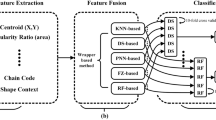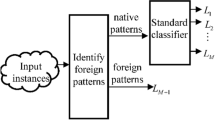Abstract
In this study, we focus on the design and refinements of granular pattern classifiers, namely classifiers, which deal with a collection of information granules formed in a certain feature space. The development of this category of classifiers is realized as a two-phase design process. First, information granules occupying some regions of the feature space are formed through invoking mechanisms of clustering or fuzzy clustering. As a result, regions in the feature space are built, which are densely occupied by the patterns predominantly belonging to the same class. We offer a detailed way of assessing the character and quality of information granules and their information (classification-oriented) content. The resulting description is utilized in the realization of the classification mechanism being considered at the second phase of the design of the granular classifier. The mapping from the collection of information granules to class assignment (classification) involves matching of a pattern to be classified to individual information granules and aggregating them by considering the information content of the corresponding granules. In the study, a number of descriptors capturing information content and aggregation functions are analyzed. To improve the performance of the granular classifier, a refinement of information granules is carried out, in which highly heterogeneous information granules (viz. those containing patterns belonging to various classes) are refined (split, specialized), and their refined versions are afterwards used in the buildup of the classifier. A series of experiments involving both synthetic data as well as those publicly available is reported and analyzed, illustrating the main advantages of granular classifiers and their design procedure.











Similar content being viewed by others
Explore related subjects
Discover the latest articles, news and stories from top researchers in related subjects.References
Al-Hmouz R, Pedrycz W, Balamash A, Morfeq A (2014) From data to granular data and granular classifiers. In: 2014 IEEE international conference on fuzzy systems (FUZZ-IEEE), pp 432–438
Al-Hmouz R, Pedrycz W, Balamash A (2015) Description and prediction of time series: a general framework of granular computing. Expert Syst Appl 42:4830–4839
Apolloni B, Pedrycz W, Bassis S, Malchiodi D (2008) The puzzle of granular computing. Springer, Heidelberg
Bache K, Lichman M (2013) UCI Machine Learning Repository. http://archive.ics.uci.edu/ml. Accessed June 2015
Balamash A, Pedrycz W, Al-Hmouz R, Morfeq A (2015) An expansion of fuzzy information granules through successive refinements of their information content and their use to system modeling. Expert Syst Appl 42:2985–2997
Bargiela A, Pedrycz W (2003) Granular computing: an introduction. Springer Science & Business Media, Berlin
Bezdek JC (1981) Pattern recognition with fuzzy objective function algorithms. Kluwer Academic Publishers, Norwell
Breiman L, Friedman J, Stone CJ, Olshen RA (1984) Classification and regression trees. CRC Press, Boca Raton
Broomhead DS, Lowe D (1988) Radial basis functions, multi-variable functional interpolation and adaptive networks. DTIC Document1988
Chaudhuri P, Huang M-C, Loh W-Y, Yao R (1994) Piecewise-polynomial regression trees. Stat Sinica 4:143–167
Ciampi A (1991) Generalized regression trees. Comput Stat Data Anal 12:57–78
Dunn JC (1973) A fuzzy relative of the ISODATA process and its use in detecting compact well-separated clusters. J Cybern 3(3):32–57
Kim H, Loh W-Y (2001) Classification trees with unbiased multiway splits. J Am Stat Assoc 96:589–604
Kim H, Loh W-Y (2003) Classification trees with bivariate linear discriminant node models. J Comput Gr Stat 12:512–530
Kohavi R, Quinlan JR (2002) Data mining tasks and methods: classification: decision-tree discovery. In: Handbook of data mining and knowledge discovery. Oxford University Press, Inc., pp 267–276
Lin TY (2003) Granular computing. In: Rough sets, fuzzy sets, data mining, and granular computing. Springer, pp 16–24
Loh W-Y (2002) Regression trees with unbiased variable selection and interaction detection. Stat Sinica 12:361–386
Loh W-Y (2009) Improving the precision of classification trees. Ann Appl Stat 3(4):1710–1737
Loh WY (2011) Classification and regression trees. Wiley Interdiscip Rev: Data Min Knowl Discov 1:14–23
Loh W-Y, Shih Y-S (1997) Split selection methods for classification trees. Stat sinica 7:815–840
Loh W-Y, Vanichsetakul N (1988) Tree-structured classification via generalized discriminant analysis. J Am Stat Assoc 83:715–725
Pedrycz W (2001) Granular computing: an emerging paradigm, vol 70. Springer Science & Business Media, Berlin
Pedrycz W (2005) Knowledge-based clustering: from data to information granules. Wiley, New York
Pedrycz W (2013) Granular computing: analysis and design of intelligent systems. Wiley, Hoboken, New Jersey
Pedrycz W, Park B-J, Oh S-K (2008) The design of granular classifiers: a study in the synergy of interval calculus and fuzzy sets in pattern recognition. Pattern Recognit 41:3720–3735
Quinlan JR (1986) Induction of decision trees. Mach Learn 1:81–106
Therneau TM, Atkinson EJ (2011) An introduction to recursive partitioning using the RPART routines. Technical report 61. http://www.mayo.edu/hsr/techrpt/61.pdf1997
Wang X, Liu X, Pedrycz W, Zhang L (2015) Fuzzy rule based decision trees. Pattern Recognit 48:50–59
Acknowledgments
This article was funded by the Deanship of Scientific Research (DSR), King Abdulaziz University, Jeddah, under Grant No. (135-804-D1435). The authors, therefore, gratefully acknowledge the DSR technical and financial support.
Author information
Authors and Affiliations
Corresponding author
Ethics declarations
Conflict of interest
The authors declare that they have no conflict of interest.
Additional information
Communicated by V. Loia.
Rights and permissions
About this article
Cite this article
Balamash, A., Pedrycz, W., Al-Hmouz, R. et al. Granular classifiers and their design through refinement of information granules. Soft Comput 21, 2745–2759 (2017). https://doi.org/10.1007/s00500-015-1978-9
Published:
Issue Date:
DOI: https://doi.org/10.1007/s00500-015-1978-9




